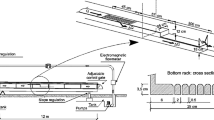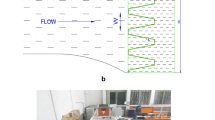Abstract
The most common type of diversion structure used in boulder streams is a trench weir. It is a simple structure built below the bed level of streams, and the top of it is covered with bottom rack. Bottom rack consists of bars of various shapes like circular, rectangle, T-shaped, etc. It is placed over the trench weir with a desired porosity to control sediment ingestion into trench. In this present study, T-shaped bars are used because sediment ingestion and maintenance in the bottom rack consisting of T-shaped bar shall likely too low as compared to the rounded bars and rectangular bars. As in previous studies, Garcia et al. (Water 10(1035):1–21, 2018a, Water 10(1699):1–21, 2018b) compared the blocking capacity of bottom intakes having circular bars with intakes having T-shaped bars, they claimed that circular bar is inefficient as compared to T-shaped bars. The present study is based on experimental investigation of trench weir consisting of T-shaped bars under free flow condition, and it was found that the coefficient of discharge decreases with an increase in clear spacing of rack, slope of bottom rack, specific energy of approach flow, Froude number and Reynolds number. An equation is also being proposed to calculate coefficient of discharge with a maximum error of ± 20%.














Similar content being viewed by others
Abbreviations
- B :
-
Width of channel, m
- a1 − g1:
-
Coefficients
- C d :
-
Coefficient of discharge
- E 0 :
-
Specific energy of approach flow, m
- Fr:
-
Froude number
- g :
-
Acceleration due to gravity, m/s2
- L :
-
Length of bottom rack, m
- L w :
-
Wetted length of bottom rack, m
- Q d :
-
Diverted discharge into channel, m3/s
- Q m :
-
Discharge in main channel, m3/s
- R :
-
Hydraulics radius, m
- Re:
-
Reynolds number
- S :
-
Upstream bed slope of main channel
- s :
-
Clear spacing of rack, m
- s r :
-
Rack slope
- t :
-
Thickness of rack, m
- V 0 :
-
Approach velocity, m/s
- V h :
-
Velocity head, m
- V h* :
-
Dimensionless velocity head, \( \frac{{V_{0}^{2} }}{{2gE_{0} }} \)
- y 0 :
-
Depth of flow in main channel upstream of rack, m
- y s :
-
Submergence depth, m
- y t :
-
Depth of flow in main channel downstream of rack, m
- ε :
-
Void ratio (ratio of clear spacing of rack to the total spacing of rack)
- μ :
-
Dynamic viscosity of water, Ns/m2
- ρ :
-
Mass density of water, kg/m3
- ξ :
-
Cd (complete withdrawal)/Cd (partial withdrawal)
References
Brunella S, Hager WH, Minor HE (2003) Hydraulics of bottom rack Intake. ASCE J Hydraul Eng 129:2–10
Castillo LG, Garcia JT, Carrillo JM (2017) Influence of rack slope and approaching conditions in bottom intake systems. Water 9(65):1–22
Castillo LG, Garcia JT, Haro P, Carrillo JM (2018) Rack length in bottom intake systems. Int J Environ Impacts 1(3):279–287
Drobir H, Kienberger V, Krouzecky N (1999) The wetted rack length of the Tyrolean weir. In: Proceeding of IAHR-28th congress, Graz
Garcia JT, Castillo LG, Carrillo JM, Haro PL (2018) Empirical, dimensional and inspectional analysis in the design of bottom intake racks. Water 10(1035):1–21
Garcia JT, Castillo LG, Haro PL, Carrillo JM (2018) Occulusion in bottom intakes with circular bars by flow with gravel-sized sediment. An experimental study. Water 10(1699):1–21
Ghosh S, Ahmad Z (2006) Characteristics of flow over bottom racks. Proc Water Engery Int CBIP 63(2):47–55
Kumar S, Ahmad Z, Kothyari UC, Mittal MK (2010) Discharge characteristics of a trench weir. Flow Measur Instrum 21:80–87
Mostkow MA (1957) A theoretical study of bottom type water intake. La Houille Blanche 4:570–580
Noseda G (1956) Operation and design of bottom rack intake racks. In: Proceeding of the 6th generation meeting IAHR, vol 3(C17), Delft, The Netherlands, pp 1–11
Ramamurthy SA, Satish GM (1986) Discharge characteristics of flow past a floor slot. J Irrig Drain Eng 112:20–27
Righetti M, Lanzoni S (2008) Experimental study of the flow field over bottom intake racks. ASCE J Hydraul Eng 134:15–22
White JK, Charlton JA, Ramsay CAW (1972) On the design of bottom intakes for diverting stream flows. In: Proceeding of Institute of Civil Engineers, vol 51, London, pp 337–345
Author information
Authors and Affiliations
Corresponding author
Additional information
Technical Editor: Jader Barbosa Jr., Ph.D.
Publisher's Note
Springer Nature remains neutral with regard to jurisdictional claims in published maps and institutional affiliations.
Rights and permissions
About this article
Cite this article
Bhave, S., Kumar, S., Singh, U.K. et al. Experimental investigation of a trench weir with T-shaped bars. J Braz. Soc. Mech. Sci. Eng. 42, 535 (2020). https://doi.org/10.1007/s40430-020-02576-z
Received:
Accepted:
Published:
DOI: https://doi.org/10.1007/s40430-020-02576-z




